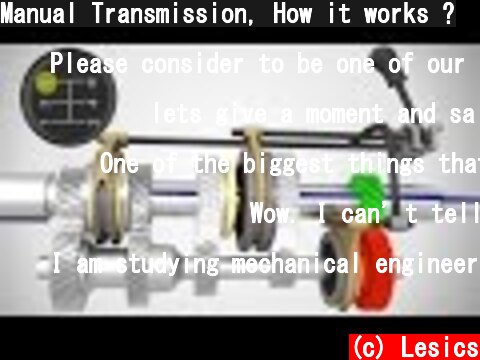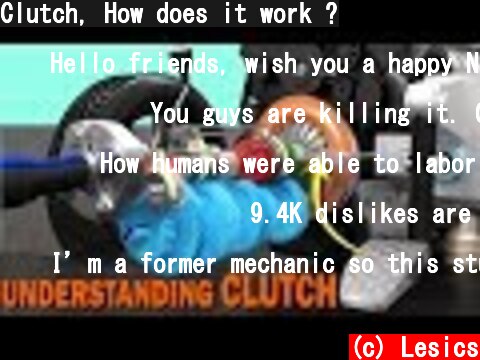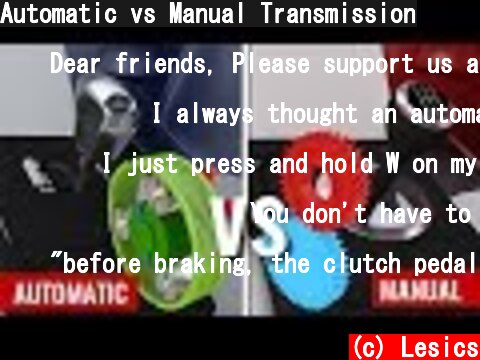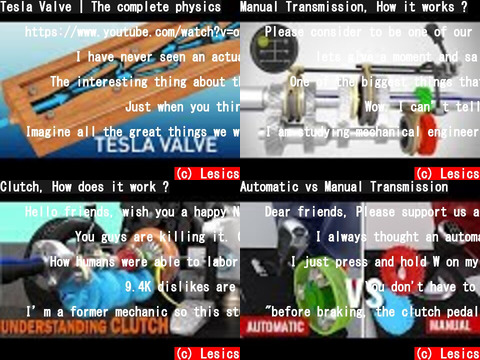- Airbags | How do they work?…
- Automatic Transmission, How it works ?…
- How does a Transformer work ?…
- Understanding Limited Slip Differential…
- Understanding Wheel Alignment !…
- Diesel Engine, How it works ?…
- Brushless DC Motor, How it works ?…
- How does an Antenna work? | ICT #4…
- Electric cars vs Petrol cars…
Tesla Valve | The complete physics

(c) Lesics Nikola Tesla had invented a very interesting one-way value. Let’s understand the complete physics of this valve in this video.
https://www.youtube.com/watch?v=ozFBsMyyDSE – Here is a simple experimental demonstration of the Tesla valve. Some people have casted doubt about its effectiveness. Trying to understand the Tesla valve and Nikola Tesla’s mind was a real fun. Thank you for the love 🙂
I have never seen an actual *working* pulsejet engine using the Tesla valve. The reason for this is that the valve is too “soft” and absorbs a lot of gas before it is “full” and the choking effect becomes pronounced enough to cause compression in the combustion chamber. For that reason, any engine built with such a valve would be unlikely to run well — if at all.
The interesting thing about this apparatus is that the reduced flow from the output side is fairly consistent no matter how much pressure is on the input side. It’s not adjustable but this would have applications where someone would need a relatively stable volume of liquid flow regardless of the changing input pressure. I think that is the real purpose of this valve, not so much being a one way valve.
Just when you think you know about all of Tesla’s amazing accomplishments, you learn about another one.
Imagine all the great things we woulda got earlier if it wasn’t for the greed of Marconi, Edison and JP Morgan. Tesla was the greatest inventor ever!
It would be more accurate to compare this to a pressure-reducing valve, rather than a check-valve / back flow preventer.
“Tesla’s valve is dangerous, immoral, illegal and nefarious!”—- Thomas Edison
As a 20 year master plumber I love the design due to it not having any mechanical parts that could fail for a pressure reducing valve this would be great
seria interessante se voces disponibilizazem legenda em outras l�nguas para este tipo de conteudo
I’ve never been more confused in my entire life watching this video. Nikola must’ve been a really smart guy, I give him a round of applause for being a smart guy
Fluid dynamics is a very interesting and very complex field and has an impact on so many day to day things that we take for granted. Tesla was a true engineering genius.
Never thought Nicola Tesla would have had anything to do with fluid mechanics
When you look at his achievements inventions and abilities, stacked against any other man throughout the entirety of humanity, that we know of, Nikolai Tesla is by far the number one greatest mine.
I noticed that secondary routes in the valve were always smaller than the target main.
I enjoy watching this every so often & it always blows me away how Tesla could think. Whudda guy!
The DeltaP seems depending on the flow rate. This will work great for mixing applications not sure about replacing check valve applications.Great mind.! Great animation. Thanks.
The counter-intuitive aspect is decreasing pressure during convergent flow. While velocity increases, one perceives that squeezing a flow into a smaller volume will increase pressure rather than decrease.
I was wondering for what he designed this when watching this video, at the end, I noticed how brilliant the design was
Makes you wonder if they had Tesla’s works in mind when designing tire treads that push rain out from under the contact patch. Cuz I’m looking at the first set uof examples up to the 3 minute mark and can’t help but see tire technology as well.
Muchas gracias por su gran trabajo…. muy bien explicado. 👍
Manual Transmission, How it works ?

(c) Lesics Help us to make future videos for you. Make LE’s efforts sustainable. Please support us at Patreon.com …
Please consider to be one of our supporters https://www.patreon.com/LearnEngineering
lets give a moment and salute the guy who animated this video
One of the biggest things that always mystified me about changing gears was how they managed to do so without grinding against each other until they engage.It’s brilliant.
Wow. I can’t tell how many videos I’ve watched over the years trying to really understand how a manual transmission works and none of them was ever able to do what this video did in 6 minutes. Excellent!
I am studying mechanical engineering first year. I have been almost crying over the book “Mechanics of Machines” that was printed in 1980 and I couldnt understand its animations. A thank you isnt enough…
This dude brilliantly explains a very complex system in such a low time and being actually easy to understand, salute.
Brilliant explanation… Finally the question “How gears gets changed without any wear and tear in their teeth at such a high speeds?” got answered… Thanks a ton… The animation was flawless and really appreciated for your hard work to explain each bit of such a mechanism which I think even the books/lecturers can’t make me understand.
This channel is phenomenal. The explanations and 3D presentations are so helpful.
Such a complex principle and he made it so easy to understand, I love cars and I’ve been trying to learn more about them in my spare time and no channel can teach you about them better than this one! I love it!
What a great video. I’ve watched other tutorials on manual transmissions and have never quite grasped it…until watching this one. I own a 10 wheeler dump truck and that has a 10 spd trans, so after watching this I can understand what is meant by the 10 spd not having the synchronizers…I have to match engine rpms and truck momentum in order to shift smoothly.
At 75, I finally FINALLY understand how synchromesh transmissions work. Thank you!
Been driving manuals for ever, so I must have missed the part about how the clutch interacts with the shifting, but enjoyed the explanation of the process….thank you!
Dude! Yes!! This makes so much more sense. My truck is manuel and now I can shift smoother! Thanks I really enjoyed this segment!!
I love the animations and everything became clear, I used to be very confused about the reverse gear but I FINALY undertand how it works, thank you
For the first time in my life, I actually get how automatics and manuals work even though the clutch is still a bit tricky. Since I was a kid, I’d wanted to know how gearboxes work, wiki was useless so thanks for this video!
FINALLY, I get it!. Thank you for explaining the standard transmission. I could never understand how you can shift gears that are constantly meshed. I also saw how synchros can wear out. Thank you for this eureka moment.
I am amazed by the efforts put by the person in this video for making ppl understand by various animations..Hats off .
This is a really helpful video, thanks! Although I had an understanding in principle, I did not know about the synchroniser ring and this makes total sense now!
This is the clearest animation and description of a manual transmission I have ever seen, particularly the operation of the locking sleeve and the synchronizer. Very good.
So awesome. I have a couple questions. First off, how does the sleeve avoid getting caught on the teeth of both the synchronizer ring and the synchronizer cone? In the animation, it just smoothly slides on by, but it’s not clear that it wouldn’t catch on those teeth.Similarly, the idle gear for reverse is a sliding mesh. It seems like it would always get caught on the other two gears, and I’m shocked that it works so well. How does the idle gear slide into place without constantly getting caught on the other two gears?Thanks so much to anyone who answers.
Clutch, How does it work ?

(c) Lesics Be a Learn Engineering supporter or contributor : https://www.youtube.com/channel/UCqZQJ4600a9wIfMPbYc60OQ/join Have …
Hello friends, wish you a happy New Year ! I hope you can make a new New Year resolution at https://www.patreon.com/LearnEngineering 🙂 Long live free education !
You guys are killing it. Great video as always.
How humans were able to laboriously figure out this high-precision engineering system is beyond amazing!
9.4K dislikes are from automatic’s drivers.
I’m a former mechanic so this stuff is second-nature to me, but this video is absolutely brilliant as a visual aid for teaching my son what the clutch pedal action is actually doing in his car. Thanks so much for creating it!
I’m literally over here watching this for fun while some poor engineering student somewhere is cramming for an exam watching this same video. Hello friend, I believe in you.
This just made such a complicated system easy to understand, wow
Neat. I’m really enjoying these. Their clear, well made, informative, and even my A.D.D. is paying attention. Once you got the whole engine breakdown, you can compile them into a full movie type thing, and sell them to schools with an automotive engineering department. If you stuck to just 10% over cost nobody would mind and you could keep the Free Learning thing your going for, while getting your stuff to people who could benefit the most from it.
I’m amazed at how an engine (including transmission) last more than 5 minutes without breaking.Pistons regularly go up and down 100 times per second.
Interesting video. Would have been nice to also learn why double-clutching was necessary in some older vehicles.
I feel like I just learned so much and understood so little at the same time.
The friction facing burned off the clutch of my 1968 Datsun 510 when the hydraulic system became clogged and left the clutch in a partially engaged position. The car was only 4 years old at the time with about 35,000 miles on it. Things have improved greatly in 50 years.
I’m so glad I found this. I’ve been trying to understand for YEARS why I half clutch the car uphill. THANK YOU MY MIND IS AT PEACE
To be honest, it’s crazy how much effort and time you put in this! GIVE THIS MAN A TV-SHOW
I love how this explains how clutch riding on hill-starts wears out everything over time. Great job.
Hey since you have a BMW model you may as well show the BMW drivers how do the indicators in their cars work.
I learnt this two years ago, when our teacher taught us a topic named clutch in mechanics of machinery course. Then I understood the basic principle of clutch. Tomorrow is my Automobile engineering exam and I watch this again. Today I understand this topic broadly. What a genius component of a car.
So I’m driving manual, for 11 years now. always somehow wondered how this works but not enough to look it up. I never knew I wanted to see your video so bad, clears up everything. really nice vid you made !!!!
Clear and concise. I’ve yet to encounter a better CGI of how a clutch operates.
Son unos de los Xxlike.Unoma�as no se laMegan: “Hotter”Hopi: “Sweeter”Joonie: “Cooler”Yoongi: “Butter”Son unos de los mejores conciertos, no puede ir pero de tan solo verlos desde pantalla, se que estuvo sorprendente.
Automatic vs Manual Transmission

(c) Lesics Which is better: Manual or Automatic transmission? This debate has been present for the last seven decades. Manual and …
Dear friends, Please support us at Patreon so that we can achieve the goal of 2 video release/month.https://www.patreon.com/LearnEngineering
I always thought an automatic transmission would just be a manual transmission but shifting it automaticlly
I just press and hold W on my keyboard to accelerate.
You don’t have to press the clutch pedal while breaking unless you are going too slow which causes the engine to stal
“before braking, the clutch pedal must be pressed completely” – I bet every driving instructor on the planet want’s to have a word right about now.
manual transmission: ok, makes senseautomatic transmission: *_IT’S WIZARDS_*
This automatic trans gave me the “missile knows where it is because it knows where it isn’t” vibes
Actually you don’t have to engage the clutch in order to brake. It just makes the transition of shifting down smoother. The clutch only has to be engaged when you’re stopped
honestly, as much as traffic makes me wish i had an automatic transmission (seriously, operating the clutch and constant swapping between the 1st and 2nd gear is a nightmare)i have to say, that in almost every other non-traffic situation, manual transmission is pure joy you basically feel every single move you makeyou can rev the engine if you wantyou feel the sudden surge of power when you change the gear and quickly release the clutch pedal while revving the enginei honestly recommend everyone to try the manual transmission at least a few times if it’s possible
The video fails to mention that in addition to the fluid coupling being inefficient in automatic vehicles automatic cars cannot account for exterior factors such as varying terrain (hills, mud or sand) until the vehicle tyres are in said terrain. By comparison in a manual you can change gear prior to driving into whatever situation may present itself, thereby reducing risk of slippage.
Please make a video on how to understand this video.
Manual transmission has a noticeable engine braking. This way you brake with both the brakes and the engine at once. I think that as an important pro, it’s not like you have to push the clutch pedal each time you brake. You can even reduce gear and stop in a shorter distance. I don’t feel safe when braking with an automatic one.
Thank You Engineers.Your ingenuity is appreciated.
3:26 “Never A Smooth expierence”My father who is driving manual for 25 years: Am i A joke to you?
I know how to drive a manual, and I love it. Honestly, there are times I find more of a power lag In an automatic than a manual. This is because the driver can learn to operate gear shifting so well they can actually reduce the amount of power lag described here to quite an unnoticeable minimum. Yes it’s still there, but it’s so minuscule that you really don’t lose any speed shifting gears. Meanwhile, most automatics are smooth, but I’ve seen more power and speed drop in an automatic trying to change gears quite often than I’ve seen in my days of driving my manual vehicle.
“never a smooth experience”I take that as an insult
6:36 That’s one of the biggest mistakes. You never disconnect the engine, by doing so on a downhill slope momentum can really take your car. Engine braking is used combined with braking. Never disengage the clutch unless you’re ready to stop completely. When you want to go slower, just go to a lower gear. Also on downhills, it’s better to be in gear and using the brake to have almost no fuel consumption.
6:38 is nonsense. You can brake without engaging clutch, just watch rpm to dont drop below minimum to dont stall engine
In order to shift as smooth as a automatic in a manual you need accelerate to the rpm you wish to shift at, lift your foot just a bit so you’re no longer accelerating but keeping constant, and then shift and complete a smooth clutch and accelerator exchange
In the automatic you may have a smoother experience in shifting gears, but less control. Try slowing down the vehicle by simply removing your foot of the accelerator. In an automatic, you may obtain the same speed as you did before, which means the brake pedal will have to be applied. In an manual transmission, the engine does the work in slowing the car when the accelerator is released, thus saving the use of brakes. To slow down faster, shift down to a lower gear. You may try this in an automatic, but some automatics will only shift down when the engine is at a certain RPM, so brake will have to be applied anyway. This is why manual transmission is better than automatic.
Differential | How does it work?

(c) Lesics Let’s understand the working of differential gearbox of an automobile in this video. This video is a re-release of an our old …
Whoever created the differential is a genius. I didn’t think that differentials were this simple and compact.
For Christmas 1962 I got a large scale model car. Although I had to assemble the differential I didn’t completely understand the mechanics. After all these years it is nice to have such a clear explanation and animated illustration of its operation.
Didn’t really plan on learning about differentials today, however this is just beautifully explained and animated!
This is the best animation I’ve ever seen that demonstrates how a differential works.It allows the viewer to visually sense how the torque is transmitted at the two different speeds.
The differential is probably the most neglected and under appreciated, yet absolutely essential part of a vehicle.
And i have just learned in less than five minutes what people in the past have taken hours to try to explain. Excellent diagram and graphics 👍🏿
After trying to get my head around this for years I finally understand thanks to the time you took to create these super clear animations. Thank you
I’m not a mechanic, but I love that I learned this. I never knew the wheels moved at different speeds during turns
Amazing animations help make this quite clear. However, the part about velocity (of spider and side gears) was a bit opaque (again the animation helped, but the terms and the arrows shown from an isometric angle were not the easiest to grasp intuitively)–maybe rotating the view to on top during that section might help?
I never even would have thought about the back wheels needing to go through turns, let alone figuring out a solution like this. Holy crap people are smart.
There are endless possibilities when it comes to physics and engineering… the design of the differential is very clever! Hats off to whoever came up with the design! I know that one wasn’t a simple idea thrown together overnight
Impressive that in its essence the spider gear is an inactive passive part that is automatically activated during different rpm in the wheels. genius!
I would have loved such videos back when I was studying mechanical engineering. Particularly in my turbine design classes. They would have helped in my electrical engineering classes too!
Absolutely BRILLIANT teaching. I love seeing the awesomeness of human ingenuity….rather than destruction. Wonderful videos!!! Bravo!!👏👏👏👏🤩
Well done, wish we had this teaching technology back in my old school days. 👍
See, this is the kind of clear and well-explained and depicted animation that is needed for these kinds of things. I’ve heard of WHAT differentials are, and what they’re meant to do, but could never visualize them and see them in action to really understand how the motion is working. This was great.
Great video. Just one correction to make: an open differential sends nearly the same 50:50 split torque to both the driven wheels.
Wow! I never thought that I’d understand how an open differential works. Great video.
Wow when I saw the diagram I was confused how it works I was waiting how you are gonna explain this to us surprisingly you explained really well thanks, and those who invented these gears mechanism is pretty brilliant.
Wow… Fantastic! My husband is an airplane mechanic and loves watching these kind of videos. When I was a child, my dad was in charge of tractor drivers when part of the Federal route of Brazil Rio/Bahia was building, around 1950’s, and he had a room just for his tools and equipment that he had to work with, so I always enjoyed being around heavy machinery, tractors and its equipments and tools.. loved this video.. thanks a lot, it brought me back good memories of my dad, which I miss a lot!














![岡田斗司夫 [切り抜き] 編集ちゃんねる(Youtube 動画 pick up)](https://imitoha.com/c/imgc/UCwfyW7i8kAFUj8_tSSDT_PA/-a-input.jpg)









コメント